NCERT Exemplar Solutions for Class 11 Biology Chapter 2 Biological Classification
These Solutions are part of NCERT Exemplar Solutions for Class 11 Biology. Here we have given NCERT Exemplar Solutions for Class 11 Biology Chapter 2 Biological Classification.
VERY SHORT ANSWER QUESTIONS
Question 1.
What is the principle underlying the use of cyanobacteria in agricultural fields for crop improvement?
Solution:
Cyanobacteria are abfs to fix atmospheric nitrogen and make it available to the plants and thus are used in agricultural crop improvement.
This improves crop yield and also reduces the cost of application of nitrogen fertilisers, e.g., Anabena and Nostoc.
Question 2.
How is the five kingdom classification advantageous over the two kingdom classification?
Solution:
The five kingdom classification, proposed by RH whittaker is based upon cell structure, body structure (unicellular, multicellular), nutrition (autotrophic, heterotrophic) reproduction and habitat either aquatic, terrestrial, or aerial and phylogenetic relationship.
It is thus more useful as compared to two kingdom system of classification which does not distinguish between prokaryotes and eukaryotes and no other kingdom except plant and animal are identified.
Polluted water bodies have high growth of algae due to the presence of nutrient. These nutrients increase the rapid growth of water plants, i.e.,
Question 3.
Polluted water bodies have usually very high abundance of plants like Nostoc and Oscillitoria. Give reasons.
Solution:
algae especially Nostoc and Oscillitoria, etc., and result in colonies. These colonies are generally surrounded by a gelatinous sheath and leads to the formation of blooms in water bodies.
Question 4.
Are chemosynthetic bacteria autotrophic or heteroterophic?
Solution:
Chemosynthetic bacteria are capable of oxidising various inorganic substances such as nitrates, nitrites and ammonia and use the released energy for production of ATP and thus they are autotrophs and not heterotrophs.
Question 5.
The common name of a pea is simpler than its botanical (scientific) name Pisum sativum why then is the simpler common name not used instead of the complex scientific/botanical name in biology?
Solution:
The common or vernacular names cause confusion regarding the identification of specific specimen as they change with the change in place whereas the scientific names are in latin and universally accepted and understood. Scientific names are thus preferred over the common vernacular names.
SHORT ANSWER QUESTIONS
Question 1.
Diatoms are also called as ‘pearls of ocean’, why? What is diatomaceous earth?
Solution:
- Diatoms and desmids are included under chrysophytes, kingdom-Protista.
- These are the main producers in the ocean. They prepare food for themselves and for the other life forms in the ocean as were a siliceous shell known as frustule cores the body of diatoms, this is the reason they are also called as ‘pearls of ocean. ‘
- Diatomaceous earth’ is the accumulation of large deposits of diatoms that forms a siliceous covering extending for several 100 metres formed in billions of years.
- The material obtained from these deposits is used in polishing and filtration of oils and syrups.
Question 2.
There is a myth that immediately after heavy rains in forest, mushrooms appear in large number and make a very large ring or circle, which may be several metres in diameter. These are called as ‘fairy rings’. Can you explain this myth of fairy rings in biological terms?
Discuss the mycilial structure in Agaricus and its soil borne nature.
Solution:
The fruiting bodies in Agaricus are known as basidiocarps. They form a concentric ring like structure from the mycelium present in the soil. These basidiocarps resemble button in shape and develop to form a ring like structure.
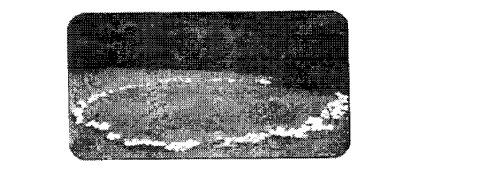
This fairy ring structure in Agaricus stimulate productivity in plants. This rings are the fruiting bodies of this fungus and the diameter of this fairy ring increases every year due to the spread of mycelium.
Question 3.
Neurospora an ascomycetes fungus has been •arsed as a biological tool to understand the mechanism of plant genetics much in the same way as Drosophila has been used to study animal genetics. What makes Neurospora so important as a genetic tool?
Solution:
Neurospora fungus can be grown easily under laboratory conditions by providing ‘minimal medium’ like inorganic salts, carbohydrates source and vitamin (biotin) and thus was selected to be a very good tool in genetics. The mutations can be also easily introduced in the fungal cells and meiotic division can be easily seen under X-ray treatment.
Question 4.
At a stage of their cycle, ascomycetes fungi produce the fruiting bodies like apothecium, perithecium or cleistothecium. How are these three types of fruiting bodies different from each other?
Discuss the type of fruiting bodies formed by ascomycetes fungus and differentiate accordingly on the basic of there structures.
Solution:
Ascomycetes consist of sporangial sac called ascus. Asci (singular-ascus) may occur freely or in aggregated form with dikaryotic mycelium to form the fruitification bodies called ascocarps.
The fruitification formed by asci include the following :
(i) Apothecium is cup like structure, e.g., Peziza.
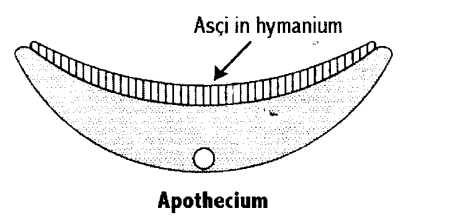
(ii) Perithecium is flask shaped, e.g., Neurospora

(iii) Cleistothecium is closed with a slit, e.g., Penicilium
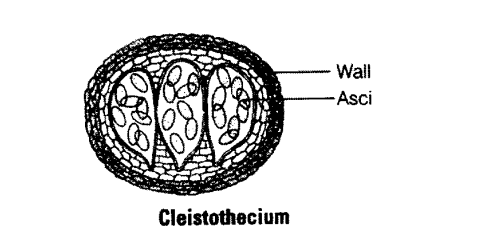
Question 5.
What obsrevable features in Trypanosoma would make you classify it under kingdom- Protista?
Discuss cell structure of Trypanosoma also discuss its different strain brief.
Solution:
Trypanosoma is included under flagellated protozoans on the basis of locomotary organ. It resembles Protisia in the following characters.
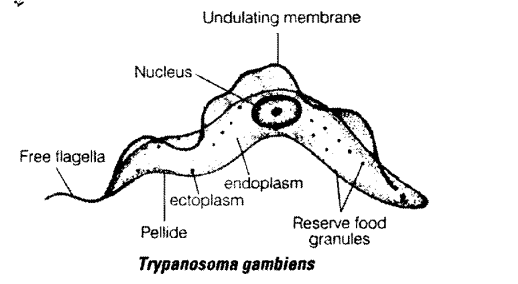
(i) It is unicellular.
(ii) It reproduces asexually i.e., by binary fission.
(iii) Possess centrally located nucieus and also contain an prominent nucleus endosome.
(iv) Reserve food material is in the form of granules.
LONG ANSWER QUESTIONS
Question 1.
Algae are known to reproduce asexually by variety of spores under different environmental conditions. Name these spores and the conditions under which they are produced.
Solution:
Asexual reproduction in algae is very common mean of reproduction. Algae and their spores exhibit significant diversity and vary greatly in their level of specialisation. Asexual reproduction by spores and their types include:
(i) Zoospores are mobile flagellated spores. In this protoplasm of each vegetative cell undergoes repeated longitudinal division either into 2 or 4, rarely 8 or 16 daughter protoplasts. Before the onset of division the parent cell loses its flagella.
- Each daughter protoplast after the last series of division secretes a cell wall and a neuromotor apparatus that develops two flagella, eyespots and contractile vacuoles.
- Each of the daughter cell thus formed resembles the parent cell in all aspects except the small size.
- Under favourable conditions formation of zoospores is very common.
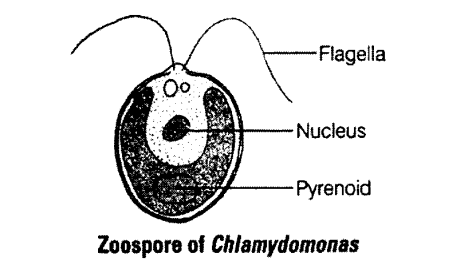
(ii) Aplanospores are the non-motile spores. They are formed asexually within a cell, in which protoplast withdraws itself from the parent wall, rounds up and develops into aplanospores which germinate either directly or may divide to produce zoospores.
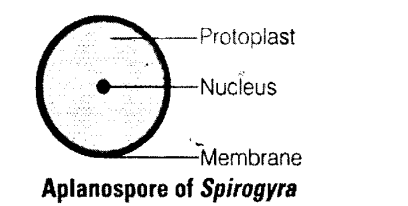
(iii) Hypnospores- In this, the protoplasm withdraws from the cell wall, rounds up and develops a thick wall under unfavourable conditions. These resting spores are called as hypnospores. Due to presence of haematochroma they are red in colour e.g., Vancheria, Ulothrix.
(iv) Akinetes are special vegetative thick walled cells present in the filaments which remain under dormant state and resume germination under favourable conditions. They can also withstand unfavourable condition as Spirogyra.
(v) Statospores are thick walled spores ‘ produced in diatoms.
(vi) Neutral spores are the protoplast, of vegetative cells directly functioning as spores (e.g., Ectocarpus).
Question 2.
Apart from chlorophyll, algae have several other pigments in their chloroptast. What pigments are found in blue, green, red and brown algae, that are responsible for their characteristic colours?
Solution:
- All photosynthetic organisms comprise of one or more organic pigments that are capable of absorbing visible, radiations, which will initiate the photochemical reaction of photosynthesis.
- The three major classes of pigments found in plants and algae are the chlorophylls, the carotenoids and the phycobilins.
- Carotenoid and phycobilins are called accessory pigments since, the quanta absorbed by theese pigments can be transferred to chlorophyll.
- The diversity of light harvesting pigments in alga implies that the common ancestor was primitive and that no close affinity exist between blue, green, red, brown, golden brown and green algae.

Question 3.
Make a list of algae and fungi that have commercial value as source of food, chemicals, medicines and fodder.
Solution:
Algae
Around 70 species of marine ailgae are used for food, chemical and medicinal purpose.
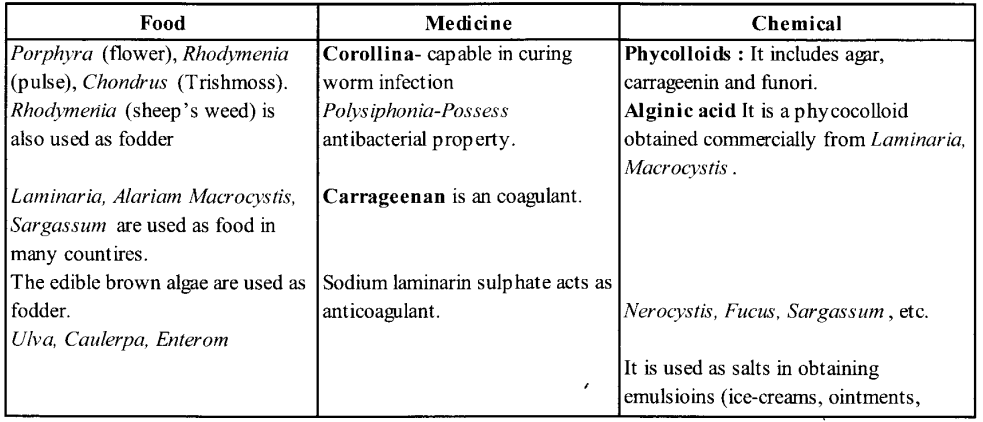
Fungi
The role of fungi was established in early history. Since, the beginning of cultivation yeast have been used in making of bread and alcohol. The discovery of penicillin that marked the beginning of a new approach to microbial dis eases in human health.
Products of fungi in medicine, chemical and food include.
Around 70 species of marine aigae are used for food, chemical and medicinal purpose.
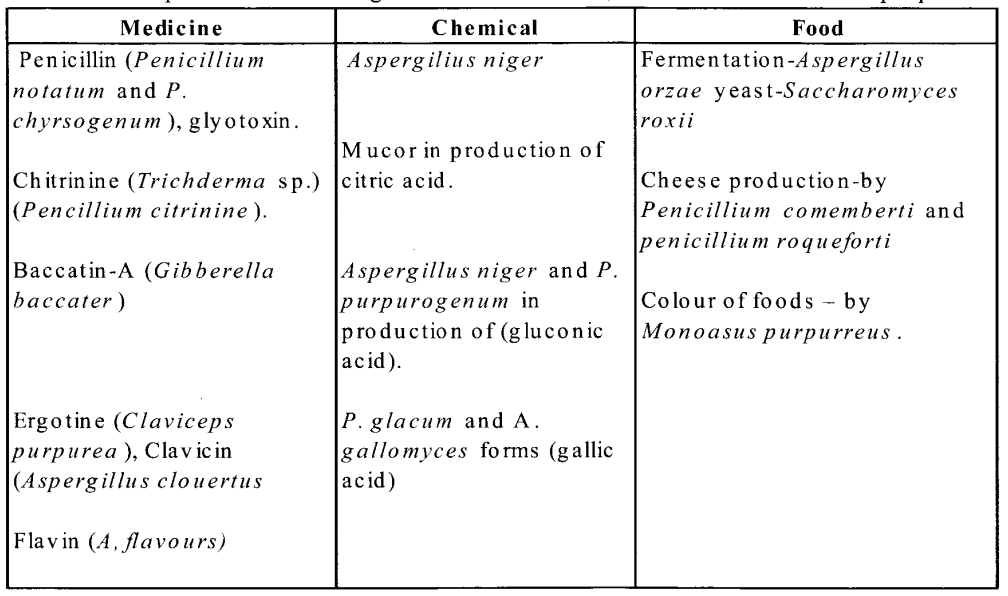
We hope the NCERT Exemplar Solutions for Class 11 Biology at Work Chapter 2 Biological Classification, help you. If you have any query regarding NCERT Exemplar Solutions for Class 11 Biology at Work Chapter 2 Biological Classification, drop a comment below and we will get back to you at the earliest.